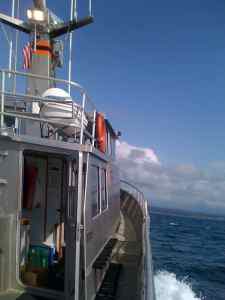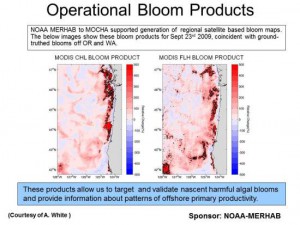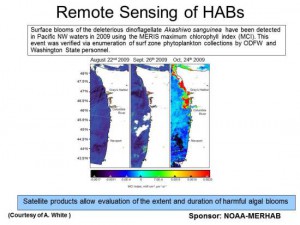Early Warning of Oregon HAB Events

In July 2010, NOAA and Oregon partners forecasted rising algae cell and toxin levels nearshore, providing state officials advance warning of a coast-wide harmful algal bloom (HAB) event and prompting proactive shellfish testing. The prediction was verified when further testing revealed that levels of the HAB toxin domoic acid exceeded regulatory limits in razor clams. The extent of this HAB outbreak forced officials to close razor clam fisheries along roughly two-thirds of Oregon’s coast. In late August, an advance warning of a second HAB event also proved correct and the state expanded the closure to include mussels. By September, the steady stream of monitoring data provided evidence that both threats had begun to diminish. This gave officials time to safely reopen recreational shellfish harvests in October.
NOAA HAB Research Pilot Project
The early warning was possible because a team from Oregon had successfully competed for limited HAB research funding and NOAA initiated the regional MERHAB project called, ‘Monitoring Oregon’s Coastal Harmful Algae’ (MOCHA). MOCHA was active from 2007 to 2014. Prior to MOCHA little was known about Oregon oceanographic conditions that promoted the growth of toxin-producing HABs, how HAB toxins got into harvestable shellfish. The two state agencies responsible for managing recreational shellfishing had no early warning system and depended solely on measuring toxin levels in shellfish. If level exceeded regulator thresholds Oregon officials had few options but to issue coast-wide closures which had economic impacts within communities dependent on shellfish diggers and related tourism. A 2009 state sponsored estimate valued recreational shellfisheries at at least $31 million to Oregon coastal communities.
Benefit of HAB Monitoring Programs
HAB-related shellfish closures have been a public health concern in Oregon for many decades. Consuming HAB toxin contaminated shellfish can cause a range of human health issues ranging from mild to severe gastrointestinal distress and vomiting, short-term memory loss, and in extreme cases paralysis and death. Oregon has been testing shellfish for levels of the algal toxin saxitoxin since the 1950s. In the 1990s, domoic acid emerged as a new threat and has been monitored in Oregon shellfish since 1994. Monitoring in near shore waters started in 2005. Other toxins and related HAB species have more recently caused concern in Oregon.

Oregon state agencies felt expanded nearshore HAB monitoring would offer shellfish harvesters greater confidence that the seafood they gather was safe and healthy and had been aware of the benefits of a previously NOAA funded regional HAB project that had successfully transitioned to state funding in Washington State. Like the neighboring ORHAB project, Oregon officials hoped the MOCHA project would enable them to both mitigate the economic impacts of HAB events while also continuing their strong record of protecting public health from HAB toxins.
In an earlier endorsement for MOCHA, Alex Manderson, a shellfish Specialist with the Oregon Department of Agriculture Food Safety Division stated, ‘the regular HAB monitoring program is critical to us because it has given us more lead time to make decisions with greater confidence that ultimately protect public health while minimizing the economic impacts of HAB closures on our valuable recreational shellfisheries.’
Advancing HAB Forecasting for Oregon
In addition to the vital nearshore monitoring of these algal species and HAB toxins, MOCHA scientists also monitored Oregon’s coastal ocean. Offshore data collected by MOCHA completed a missing piece of the puzzle in our understanding of ocean conditions along the Pacific coast which are conducive to the formation of toxic algae blooms. MOCHA integrated offshore and near shore HAB monitoring data into a comprehensive database that includes environmental conditions, HAB species abundance, and toxin levels.
The MOCHA team used this database to identify potential HAB ‘hotspots’ or locations that may spawn a toxic bloom. MOCHA data is already being used to test and develop models which may one day enable more than the week or two early warning the team demonstrated in 2010. Such forecasts are a key goal of NOAA HAB investments in every coastal region.
Despite the MOCHA team’s successful demonstration that enhanced monitoring can give an early warning of HAB events, the challenging budget climate in Oregon state agencies prevented the program from transitioning to sustainable funding before NOAA funding ended. Unlike in Washington State the future of HAB early warning in Oregon remains uncertain.

However NOAA funding of MOCHA had a number of major advances including:
- Sampling for toxins in the surf zone and offshore region revealed that saxitoxin is a more persistent and regular threat to Oregon shellfish than domoic acid poisoning which shows high interannual variability. Moreover, we have shown that Alexandrium cell counts closely track saxitoxin levels in shellfish and thus provide a low-cost, rapid and effective means of early warning for potential paralytic shellfish poisoning.
- MOCHA has developed satellite-based bloom products for both MODIS and VIIRS Suomi-NPP ocean color products (chlorophyll concentrations and fluorescence line height). Significantly, we have shown that these products successfully identify growth of phytoplankton within a reasonable error margin. MOCHA satellite bloom products are currently served by NOAA ERDDAP and have been utilized by local resource managers for the identification and monitoring of harmful algae in this region.
- MOCHA project scientists documented the occurrence, spatial extent and ecological consequences of a rare albeit massive bloom of the dinoflagellate Akashiwo sanguinea in 2009-2010. This bloom spanned the coastlines of both Washington and Oregon and led to widespread deaths of seabirds. Monitoring agencies are now aware and on alert for the occurrence of this deleterious organism under warm conditions.
- Extensive and parallel sampling of phytoplankton cell counts and shellfish toxins revealed that measures ofPseudo-nitzschia cell abundance alone is insufficient to track domoic acid (DA) in shellfish. Rather, MOCHA efforts have demonstrated that in situ measurements of particulate and dissolved DA are far more valuable and may be good indicators of potential shellfish toxicity several weeks in advance of measured toxicity.
- Based on 10 years of phytoplankton species abundance data, we have found clear evidence for links between basin scale climactic indices and phytoplankton community structure in Oregon coastal waters. When the Pacific Decadal Oscillation is in a negative (cool) phase, the abundance of diatoms are at their highest levels whereas during a positive (warm) phase, the abundances of diatoms decline by 2-3 times and the relative abundance of dinoflagellates increases. This indicates the PDO as a powerful indicator of relative HAB risk (e.g. dinoflagellate/saxitoxin versus diatom/domoic acid).
This project was funded through NOAA’s national Monitoring and Event Response for Harmful Algal Bloom (MERHAB) program. Given limited funding for HAB research, NCCOS is committed to maintaining, a regional, competitive approach for MERHAB and other National HAB Research programs.
Related MERHAB funded MOCHA project links
Operational Products (ERDAPP)
- OSU Fluorescence Line Height Bloom Product, Aqua Modis, Northwest US, 2002-present
- OSU Chlorophyll Bloom Product, Aqua Modis, Northwest US, 2002-present
- OSU Chlorophyll Bloom Product, VIIRS Suomi-NPP, Northwest US, 2012-present
Open Access Publications (subset of full MOCHA publication list)
- Seasonal Cycle of Phytoplankton Community Composition in the Coastal Upwelling System Off Central Oregon in 2009
- Large-scale bloom of Akashiwo sanguinea in the Northern California current system in 2009
- Satellite-based detection and monitoring of phytoplankton blooms along the Oregon coast
- Harmful algal blooms along the North American west coast region: History, trends, causes, and impacts
- Relationships among upwelling, phytoplankton blooms, and phycotoxins in coastal Oregon shellfish
For more information, contact Marc.Suddleson@noaa.gov.
